Thai Fish Curry: Easy, Creamy, and Perfect for Weeknights
Thai Fish Curry is more than just a recipe; it’s a vibrant culinary journey that celebrates the perfect harmony between spices, creamy coconut milk, and fresh seafood. At JustThaiRecipes, the About page tells the inspiring story of Lina, a passionate cook who, with her partner, began sharing authentic Thai dishes to bring the bold, beautiful flavors of Thailand into homes worldwide. This article is built on that same passion and aims to guide you through every detail of crafting a delicious Thai Fish Curry from choosing the right fish to mastering variations like coconut fish curry and Goan fish curry. You’ll also learn serving ideas, health benefits, and expert tips to elevate this dish.
If you’re a fan of hearty, comforting meals, Thai Fish Curry is bound to become a favorite. With its balance of spice, sweetness, and creaminess, this dish captures the essence of Thai cuisine while offering flexibility to suit your taste. Learn more about Classic Thai Chicken Curry to expand your Thai cooking repertoire.
Table of Contents
Table of Contents
Understanding Thai Fish Curry
What is Thai Fish Curry?
Thai Fish Curry is a flavorful Southeast Asian dish featuring tender white fish simmered in a luscious coconut milk sauce infused with Thai red curry paste. It’s known for its comforting, slightly spicy flavor and aromatic blend of herbs and spices. Unlike many fish curries around the world, the Thai version relies heavily on fresh ingredients, resulting in a light yet creamy dish that is both satisfying and wholesome.
This curry usually incorporates a mix of vegetables such as green beans, carrots, and bell peppers, creating a balanced and colorful plate. The fish absorbs the curry sauce beautifully, making every bite rich and flavorful.
Origins and Cultural Significance
The roots of Thai Fish Curry lie deep in Thailand’s coastal regions, where seafood is abundant and coconut palms thrive. Thai cuisine traditionally balances the four main flavors—sweet, sour, salty, and spicy and this dish is a perfect example of that harmony. Over the years, Thai Fish Curry has spread across the globe, gaining popularity not just in restaurants but also in home kitchens thanks to its straightforward preparation and versatility.
Thai Fish Curry isn’t just food; it’s a representation of Thailand’s culinary identity. The use of curry paste, a blend of chilies, lemongrass, garlic, galangal, and spices, sets the tone for the dish, while coconut milk softens the heat and adds depth. This dish often appears at family gatherings and special occasions, symbolizing warmth, hospitality, and shared moments at the table.
Looking for inspiration? Try Hainan Chicken Rice as another example of how Thai flavors turn simple ingredients into extraordinary meals.
Key Ingredients for an Authentic Thai Fish Curry
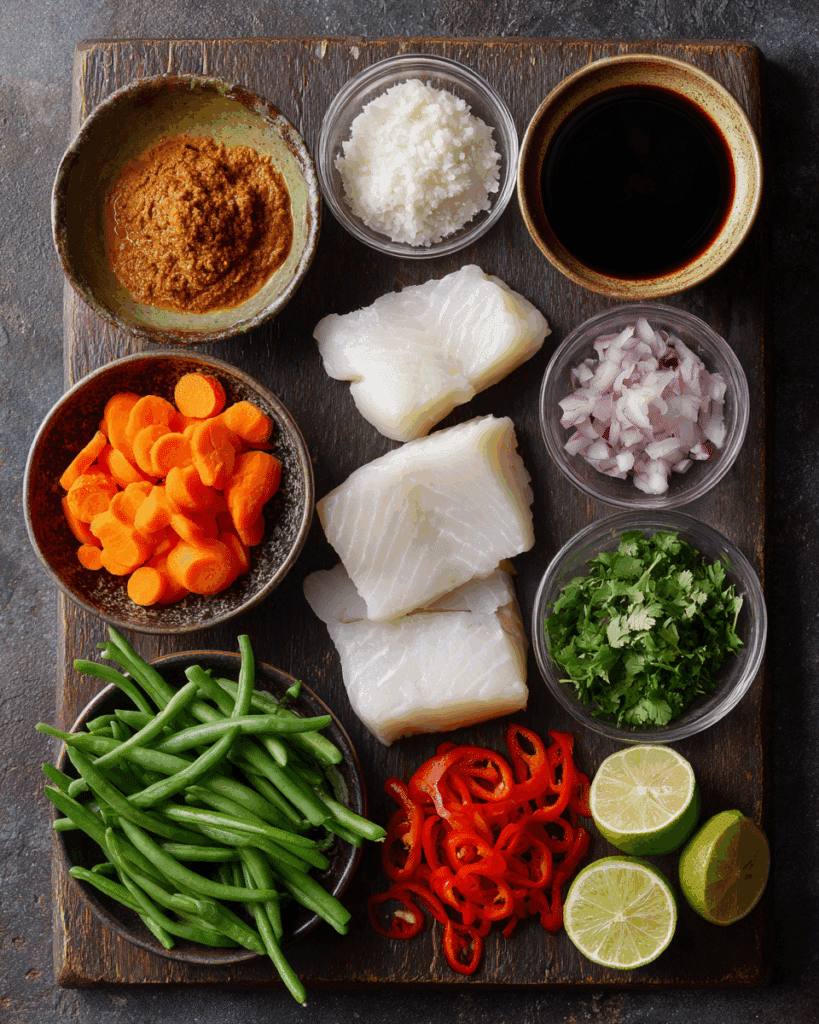
Crafting the perfect Thai Fish Curry starts with choosing the right ingredients. Each component plays a crucial role in building the layers of flavor that make this dish unforgettable. Let’s break down what you’ll need and why it matters.
Fresh Fish Choices
The star of Thai Fish Curry is, of course, the fish. Selecting the right type ensures the curry has the right texture and absorbs the sauce beautifully. The best options include:
- Cod – Mild and flaky, perfect for soaking up the rich curry sauce.
- Halibut – Firm and meaty, it holds its shape well during cooking.
- Tilapia – Affordable and readily available, making it ideal for a quick meal.
When shopping for fish, opt for fresh fillets whenever possible. If using frozen, thaw completely and pat dry to prevent excess water from thinning the sauce. The fresher the fish, the better the final flavor.
Essential Thai Ingredients
Beyond the fish, Thai Fish Curry owes its unique taste to a handful of traditional Thai ingredients. These staples are easy to find and absolutely worth it:
- Red Thai Curry Paste – The heart of the dish, offering heat, depth, and aromatic spices.
- Coconut Milk – Creates the creamy base that softens the spice and ties everything together.
- Fish Sauce – Adds umami richness and a savory kick.
- Coconut Sugar or Brown Sugar – Balances the heat with a hint of sweetness.
- Aromatics – Fresh ginger, garlic, and onion provide a fragrant base.
- Fresh Veggies – Green beans, carrots, and bell peppers add color, crunch, and nutrition.
- Fresh Herbs – Cilantro and a squeeze of lime juice at the end bring brightness to the dish.
These ingredients are not just staples in Thai cooking; they also contribute to the curry’s balance of flavors—spicy, sweet, salty, and slightly sour.
Check out Coconut Mango Chicken Curry to see how similar ingredients can be transformed into a dish with a completely different profile.
Why Ingredient Quality Matters
In Thai cuisine, ingredient quality is everything. Using fresh vegetables and high-quality coconut milk can turn a simple fish curry recipe into an extraordinary meal. Even the curry paste you choose makes a difference store-bought versions are convenient, but homemade paste can elevate the dish even further.
Don’t miss our Thai Basil Fried Rice where fresh herbs and quality seasonings also shine, proving that great ingredients make all the difference.
Step-by-Step Cooking Instructions
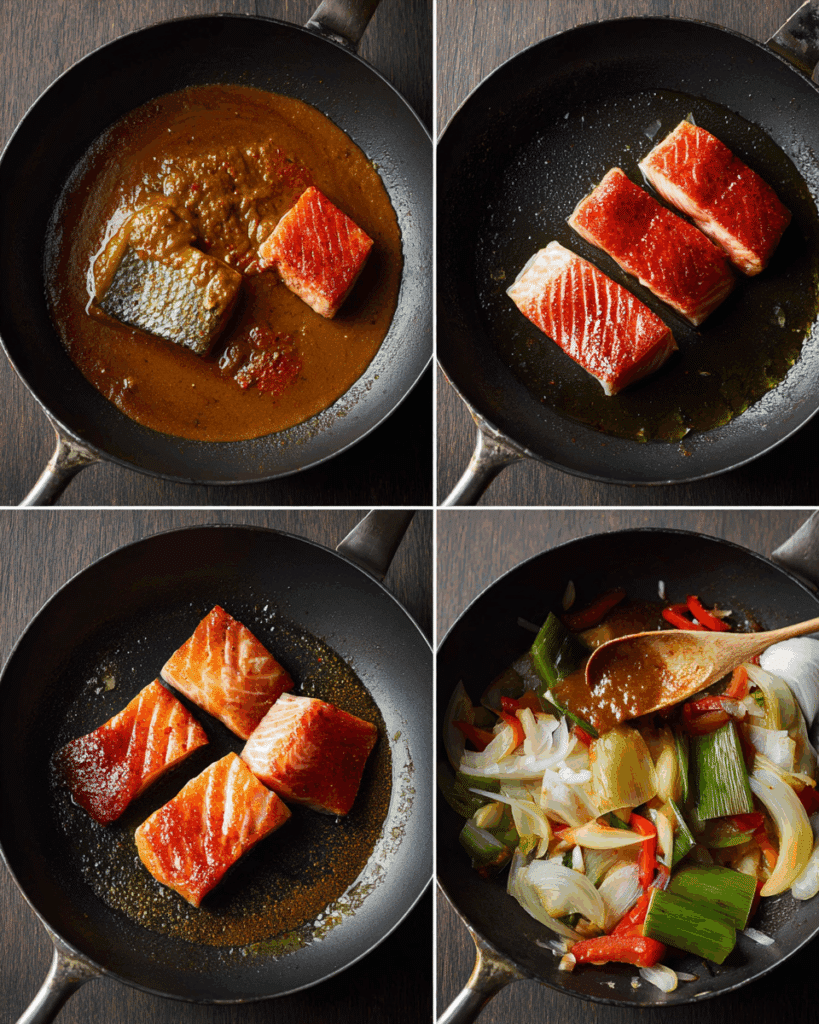
Making Thai Fish Curry is easier than it looks, yet the result is deeply flavorful and restaurant-worthy. By following a few simple steps, you can recreate this authentic dish in your own kitchen.
Preparing the Fish
Start by cutting your white fish into pieces about two inches wide. This size allows the fish to cook evenly and absorb the flavors of the sauce. Use a paper towel to pat the pieces dry. This step prevents excess water from diluting the curry. Once dry, rub the fish with one tablespoon of red Thai curry paste. This quick marinade infuses the fish with flavor even before it hits the pot.
For more ideas on preparing fish with curry paste, explore The Endless Meal’s Thai Fish Curry which also emphasizes how pre-marinating enhances taste.
Cooking the Aromatic Base
Heat coconut oil in a large pot or braiser over medium-high heat. When the oil shimmers, add finely minced onion, ginger, and garlic. Sauté these aromatics for about five minutes until golden brown and fragrant. This creates the flavorful base of the curry.
Next, stir in the remaining two tablespoons of red Thai curry paste. Toasting the paste in oil unlocks its deep flavors. Follow with coconut milk, water, fish sauce, and coconut sugar. Stir well to combine and bring the mixture to a gentle boil.
Looking for a spicier option? Hungry in Thailand’s Thai Red Curry Fish offers tips on boosting heat while keeping flavors balanced.
Adding Vegetables and Fish
Add your chopped vegetables—green beans, carrots, and red bell peppers work beautifully. These veggies not only add color but also texture and nutrients. Let them simmer in the sauce until slightly tender.
Once the vegetables are nearly cooked, reduce the heat to medium-low. Gently place the fish pieces into the pot. Cover and let simmer for about five minutes, or until the fish is opaque and flakes easily with a fork. If the fish pieces are thick, flip them halfway through cooking for even doneness.
Finishing Touches
Before serving, add a handful of minced cilantro and a squeeze of lime juice to brighten the dish. Taste and adjust seasoning if needed—adding more fish sauce for saltiness or sugar to balance spice.
For an alternative technique using cod or halibut, Julia O’Malley’s Thai-Style Coconut Fish Curry showcases how gentle simmering keeps fish tender and the sauce aromatic.
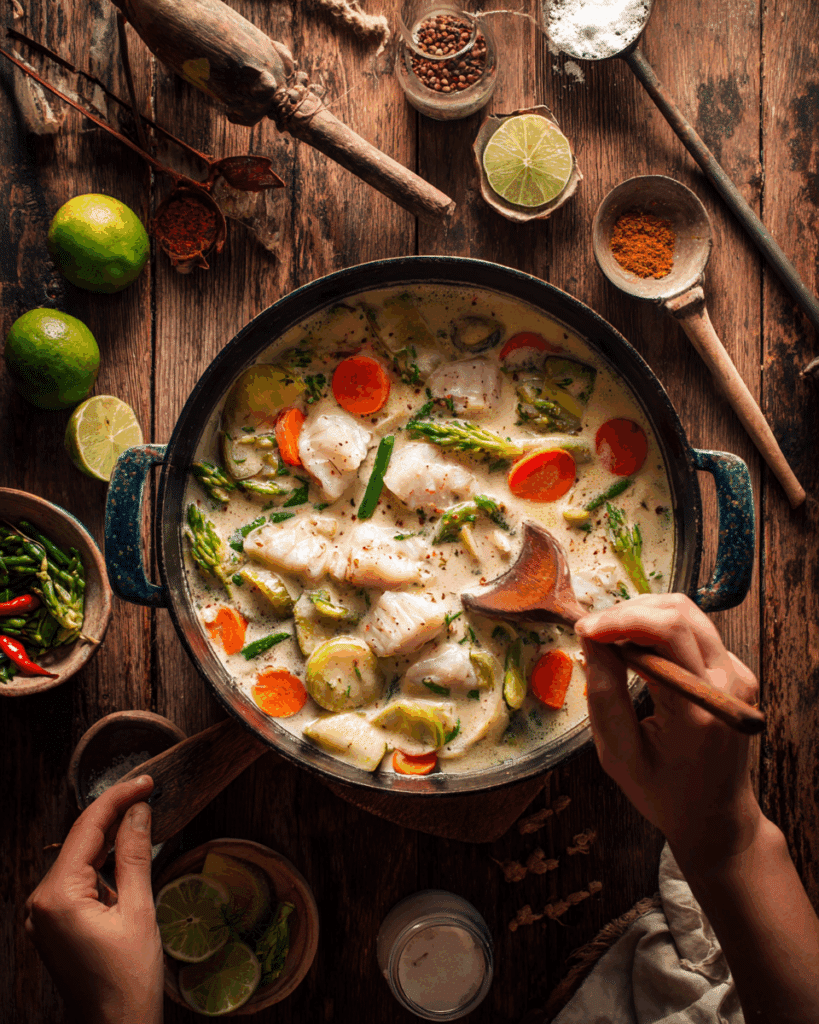
By mastering these steps, you’ll be rewarded with a bowl of Thai Fish Curry that is creamy, flavorful, and irresistibly comforting.
Tips for the Perfect Simple Fish Curry Recipe
Crafting an outstanding Thai Fish Curry goes beyond simply following a recipe. Paying attention to small details can elevate your dish from good to extraordinary. Here are expert tips to help you perfect this simple fish curry recipe every time.
Balancing Flavors
The beauty of Thai Fish Curry lies in its balanced flavor profile. To achieve this harmony, taste as you cook. If the curry is too spicy, add a bit more coconut milk or a pinch of sugar to soften the heat. If it feels too sweet, a splash of lime juice can restore balance. Fish sauce is your secret weapon for umami depth—add it gradually until the sauce has a savory richness that complements the spices. Fresh herbs like cilantro should be added at the end to preserve their aroma and vibrancy.
Texture and Consistency
The sauce of Thai Fish Curry should be creamy, not watery. Use full-fat coconut milk for the richest texture. Avoid boiling the sauce too aggressively once the fish is added, as high heat can cause the fish to break apart. Instead, let it simmer gently to maintain its delicate flakes. If your curry turns out too thin, let it reduce slightly before adding the fish. This ensures the sauce clings beautifully to the fish and vegetables.
Choosing the Right Cookware
A heavy-bottomed pot or braiser is ideal for cooking Thai Fish Curry. These types of cookware distribute heat evenly and prevent the sauce from scorching. Non-stick pans can work too but avoid excessive stirring, which can break up the fish.
Enhancing Aromatics
For an extra layer of flavor, consider adding fresh lemongrass or kaffir lime leaves while the sauce simmers. These ingredients are traditional in many Thai curries and provide a subtle citrusy aroma that elevates the dish. Remove them before serving to avoid overpowering the final flavor.
Customizing Spice Levels
Thai Fish Curry can range from mild to fiery depending on your preference. Adjust the amount of red curry paste to suit your taste. For a spicier kick, add sliced Thai chilies during cooking or serve them on the side. For a milder version, use less paste and incorporate more coconut milk.
By focusing on these small but significant details, you’ll create a curry that is consistently flavorful, creamy, and perfectly balanced. These tips transform a simple fish curry recipe into a dish that tastes like it came straight from a Thai kitchen.
Variations of Thai Fish Curry to Try
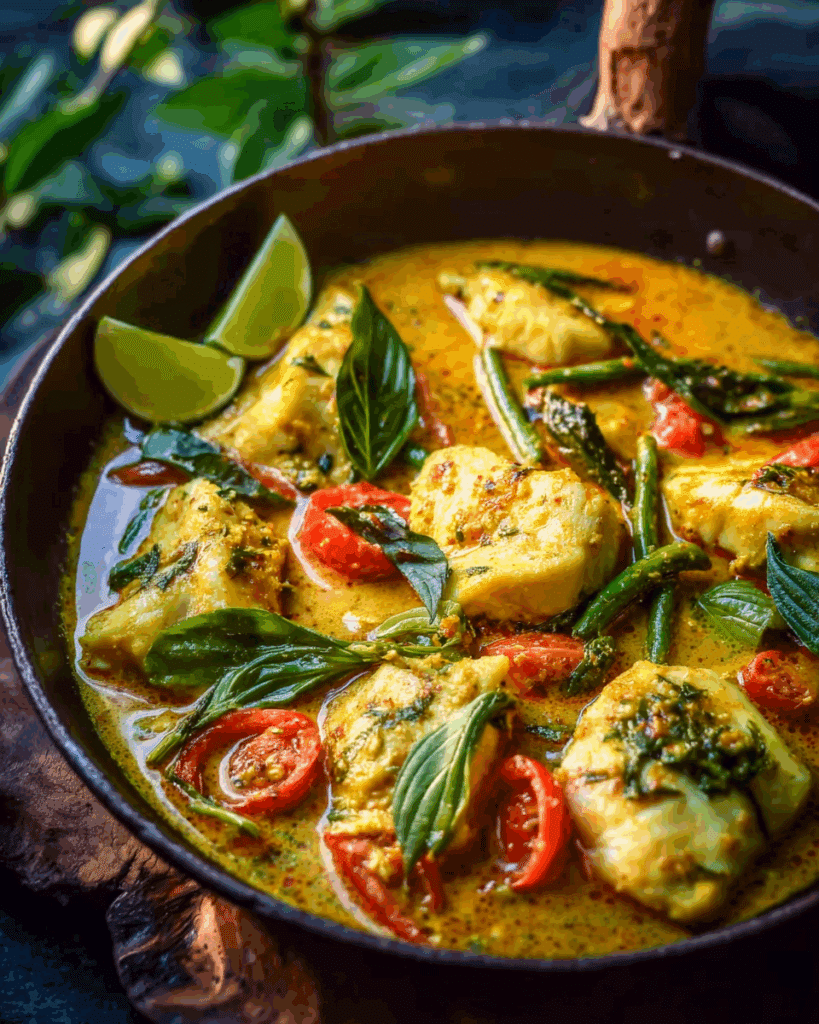
Thai Fish Curry is wonderfully versatile, and exploring different versions allows you to experience a wide range of flavors and textures. By making small adjustments to ingredients and techniques, you can create several unique styles of this beloved dish.
Coconut Fish Curry
This variation focuses on the creamy richness of coconut milk while keeping the spice level mild. Use an extra portion of coconut milk and reduce the curry paste slightly. The result is a smooth, velvety curry that’s ideal for those who prefer a gentler heat. Garnish generously with fresh herbs to enhance its delicate flavor.
Goan Fish Curry
Inspired by the coastal cuisine of Goa, this version introduces tamarind and ground spices like coriander and cumin to the curry base. The tanginess of tamarind adds a sharp contrast to the creaminess of the sauce, creating a vibrant dish that pairs perfectly with steamed rice. Use firm white fish to stand up to the bold flavors.
Green Thai Fish Curry
For a fresher, herbaceous twist, replace the red curry paste with green curry paste. Green Thai Fish Curry is typically slightly spicier and more aromatic, with flavors from ingredients like green chilies, basil, and kaffir lime leaves. Add zucchini or baby corn as vegetables to complement the vibrant green sauce.
Thai Fish Curry Jamie Oliver Style
Jamie Oliver’s take on Thai Fish Curry simplifies the process without sacrificing flavor. His version often includes fresh cherry tomatoes, spinach, and an extra splash of lime for a refreshing finish. It’s a great choice for busy weeknights, offering a bright and zesty variation with minimal effort.
Thai Fish Curry with Coconut Milk
While coconut milk is a staple in many Thai curries, this variation emphasizes it even more. Use only coconut milk as the liquid base, skipping water entirely. The result is a thick, luscious curry with an intensified coconut aroma and taste. It’s indulgent, comforting, and pairs beautifully with steamed jasmine rice.
Authentic Thai Fish Curry
To achieve an authentic Thai Fish Curry, focus on using traditional ingredients like homemade red curry paste, fresh Thai basil, and galangal. Authentic versions often include a balance of sweet, sour, salty, and spicy notes, staying true to the essence of Thai cuisine. Slow simmering and attention to seasoning are key to capturing its genuine taste.
Thai Fish Curry Red
This is the classic version that most people think of when they hear Thai Fish Curry. Made with red Thai curry paste, it strikes the perfect balance of spice, sweetness, and creaminess. Use vibrant vegetables like red bell peppers to enhance the color and flavor of this well-loved dish.
Exploring these variations not only keeps the recipe exciting but also allows you to tailor it to different preferences and occasions. Each version brings its own personality to the table, making Thai Fish Curry a dish that never gets old.
Health Benefits of Thai Fish Curry
Thai Fish Curry is not only a delicious meal but also a dish packed with nutrients that support overall well-being. Its combination of fresh fish, vegetables, and spices offers several health advantages that make it a smart choice for any diet.
Nutritional Value
The primary ingredient, white fish, is an excellent source of lean protein. Protein is essential for muscle repair, growth, and maintaining healthy energy levels. White fish is also low in fat yet rich in important nutrients like vitamin B12, iodine, and selenium. These nutrients support brain function, metabolism, and immune health.
Coconut milk, another key component, provides healthy fats known as medium-chain triglycerides (MCTs). These fats are easily digested and converted into energy, making them beneficial for maintaining stamina. While coconut milk does contain saturated fat, moderate consumption as part of a balanced diet can be part of a healthy lifestyle.
Rich in Antioxidants
The red Thai curry paste used in this dish contains spices and herbs like chilies, garlic, and lemongrass, all of which are rich in antioxidants. Antioxidants help fight oxidative stress in the body, reducing the risk of chronic diseases. Ginger and garlic, also part of the recipe, have anti-inflammatory properties that can support joint and heart health.
Benefits from Vegetables
Adding vegetables like green beans, carrots, and red bell peppers enhances the nutritional profile of Thai Fish Curry. These vegetables are loaded with vitamins A and C, potassium, and dietary fiber. They support immune function, improve digestion, and promote healthy skin. The variety of colors in these vegetables also indicates a wide range of phytonutrients, which are beneficial plant compounds.
Why It’s a Great Comfort Food
Thai Fish Curry stands out as a comfort food that nourishes both the body and the soul. Unlike many comfort dishes that are heavy or overly processed, this curry uses wholesome ingredients that offer both flavor and nutrition. The creamy texture and warming spices make it perfect for cozy nights, while the balance of flavors keeps it light enough for everyday meals.
Including Thai Fish Curry in your meal rotation allows you to enjoy something that is not only satisfying to your taste buds but also supportive of your overall health. Whether you are looking to boost your protein intake, add more vegetables to your diet, or simply enjoy a balanced and flavorful dish, this curry is a wonderful choice.
Serving Ideas and Pairings
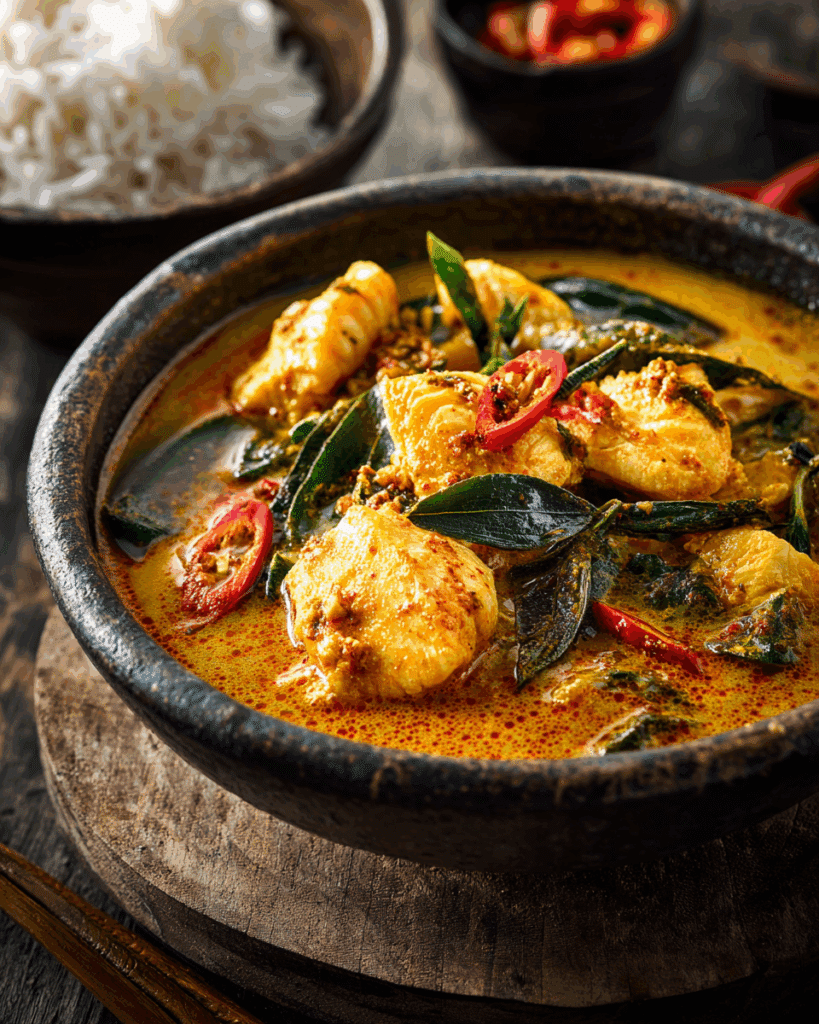
Thai Fish Curry is a versatile dish that pairs beautifully with a variety of sides and garnishes. Choosing the right accompaniments enhances its flavors and makes the meal more enjoyable. From traditional pairings to creative twists, there are plenty of ways to serve this curry.
What to Serve With Thai Fish Curry
The most common and complementary side to Thai Fish Curry is steamed jasmine rice. Its subtle floral aroma and soft texture balance the bold spices of the curry, allowing the sauce to shine. For a slightly sticky texture that holds the sauce well, try Thai sticky rice. Brown rice or quinoa can also be used as healthier alternatives while still complementing the dish’s flavors.
Another great pairing is rice noodles. Their silky texture absorbs the creamy sauce, making every bite satisfying. For a lighter option, serve the curry with cauliflower rice or a fresh salad to cut through the richness of the coconut milk.
Garnishing for Extra Flavor
Garnishes are more than decoration; they add freshness and layers of taste. Minced cilantro sprinkled on top brings a vibrant, herbaceous note that brightens the dish. A generous squeeze of lime juice enhances the overall flavor by adding a citrusy kick. For extra heat, serve with sliced Thai chilies or a drizzle of chili oil. Crushed peanuts or cashews can also be sprinkled on top for a crunchy texture and nutty undertone.
Creative Serving Ideas
For an elegant presentation, serve Thai Fish Curry in individual bowls with a side of steamed vegetables or a wedge of lime. You can also offer it as part of a Thai-inspired feast, pairing it with other dishes like papaya salad or grilled skewers. If you enjoy experimenting, try serving the curry over roasted sweet potatoes or even a bed of soba noodles for a unique twist.
Serving Thai Fish Curry thoughtfully ensures that every bite is balanced and satisfying. Whether you stick to traditional sides or get creative with modern pairings, the right accompaniments can transform a simple meal into a memorable dining experience.
Storing and Reheating Leftovers
One of the advantages of Thai Fish Curry is that it stores well and can be enjoyed later with minimal loss of flavor. Proper storage and reheating methods are essential to keep the fish tender and the sauce rich.
How to Store Properly
After cooking, allow the curry to cool to room temperature before transferring it to an airtight container. Storing it while still hot can create condensation, leading to watery sauce. Place the container in the refrigerator, where it will keep fresh for up to three days. For longer storage, portion the curry into freezer-safe containers and freeze for up to two months. Keep in mind that the texture of the fish may become slightly softer after freezing, but the flavors will remain intact.
Reheating Tips
When reheating Thai Fish Curry, use gentle heat to prevent the fish from overcooking. The best method is to warm it slowly on the stovetop over low to medium heat, stirring occasionally. If the sauce thickens too much during storage, add a splash of water or coconut milk to restore its consistency. Microwaving is also an option, but use short intervals and stir between each to heat evenly without drying out the fish.
Maintaining Flavor After Storage
Flavors in Thai Fish Curry often deepen after a day in the refrigerator, making leftovers even tastier. To refresh the dish, squeeze a little fresh lime juice over the curry just before serving. You can also add a small amount of freshly chopped cilantro to restore its brightness. If you enjoy a bit of extra heat, consider adding a few slices of fresh chili during reheating.
Proper storage and careful reheating ensure that every bowl of leftover Thai Fish Curry remains as delicious as when it was first prepared. With these methods, you can enjoy this comforting dish multiple times without compromising its quality.
Conclusion
Thai Fish Curry is more than a simple meal; it is a flavorful journey into the heart of Thai cuisine. This dish combines the delicate texture of white fish with the rich creaminess of coconut milk and the aromatic heat of red Thai curry paste. When balanced with fresh vegetables, herbs, and a squeeze of lime, it becomes a meal that is both comforting and vibrant.
The beauty of Thai Fish Curry lies in its adaptability. You can create variations such as green Thai fish curry, coconut fish curry, or even Indian-inspired versions like Goan fish curry. Whether you prefer it mild and creamy or bold and spicy, this dish offers endless possibilities for experimentation while staying true to its Thai roots.
Making Thai Fish Curry at home also allows you to control the quality of ingredients and tailor the flavor to your preferences. With the right techniques for preparation, cooking, and storage, it becomes a reliable recipe that fits into any kitchen routine. Leftovers taste even better the next day, making it a convenient choice for busy schedules.
By incorporating the tips, variations, and health benefits discussed throughout this article, you can master the art of Thai Fish Curry. Each bowl not only satisfies your taste buds but also delivers a nourishing, wholesome experience. So gather your ingredients, set aside some time, and enjoy cooking a dish that brings the warm, bold flavors of Thailand right to your table.
FAQs About Thai Fish Curry
What veggies work best in this recipe?
Green beans, carrots, and red bell peppers are classic vegetables that complement the flavors of Thai Fish Curry. However, you can also add zucchini, baby corn, or spinach to vary the texture and nutritional content. Using a mix of colorful vegetables not only enhances the dish visually but also boosts its health benefits.
Can I make Thai Fish Curry dairy-free?
This dish is naturally dairy-free because coconut milk is used instead of cream or dairy products. For those avoiding dairy, ensure that the curry paste you use does not contain any hidden dairy ingredients.
How can I make it spicier?
To increase the heat, add extra red Thai curry paste or include fresh Thai chilies while the sauce simmers. Another option is to drizzle chili oil on the finished dish for an extra kick without altering the overall flavor balance.
Can I use frozen fish for Thai Fish Curry?
Yes, frozen fish works perfectly as long as it is thawed completely before cooking. Patting the fish dry after thawing is important to prevent excess water from thinning the curry sauce. Choose firm white fish varieties such as cod, halibut, or tilapia for the best results.

Thai Fish Curry
- Prep Time: 10 minutes
- Cook Time: 15 minutes
- Total Time: 25 minutes
- Yield: 4 servings 1x
- Category: Main Course
- Method: Stovetop
- Cuisine: Thai
- Diet: Gluten Free
Description
This Thai Fish Curry is a fragrant and flavorful dish featuring tender white fish simmered in a creamy coconut curry sauce with vibrant vegetables, fresh cilantro, and a splash of lime juice.
Ingredients
- 1 ½ lb white fish
- 3 tablespoons red Thai curry paste (divided)
- 2 tablespoons coconut oil
- ½ medium onion, finely minced
- 2 tablespoons finely minced ginger
- 3 cloves garlic, finely minced
- 15 ounce can coconut milk
- ½ cup water
- 1 tablespoon fish sauce
- 1 tablespoon coconut sugar (or brown sugar)
- 4 cups chopped veggies (green beans, carrots, and red bell peppers)
- Minced cilantro, to serve
- Lime juice, to serve
Instructions
- Cut the fish into pieces about 2 inches wide. Pat dry with a paper towel, then rub 1 tablespoon of the curry paste over the pieces.
- Heat the coconut oil in a large pot over medium-high heat. Add the onion, ginger, and garlic, and cook until golden brown, about 5 minutes.
- Stir in the remaining 2 tablespoons of curry paste, then add the coconut milk, water, fish sauce, and sugar. Mix well.
- Add the chopped vegetables and bring the pot to a boil.
- Reduce heat to medium-low, add the fish pieces, cover the pot, and cook for 5 minutes or until the fish is no longer opaque. For thicker pieces, flip and cook an additional 1-2 minutes.
- Serve hot, garnished with minced cilantro and a squeeze of lime juice.
Notes
- Use any firm white fish such as cod, halibut, or tilapia.
- Adjust the spice level by adding more or less curry paste.
- Serve with steamed jasmine rice to soak up the delicious curry sauce.
- For a creamier curry, add an extra splash of coconut milk.
Nutrition
- Serving Size: 1 bowl
- Calories: 320
- Sugar: 6g
- Sodium: 650mg
- Fat: 18g
- Saturated Fat: 12g
- Unsaturated Fat: 5g
- Trans Fat: 0g
- Carbohydrates: 14g
- Fiber: 3g
- Protein: 28g
- Cholesterol: 60mg
Keywords: Thai fish curry, coconut curry fish, easy Thai curry, fish curry recipe, Thai dinner

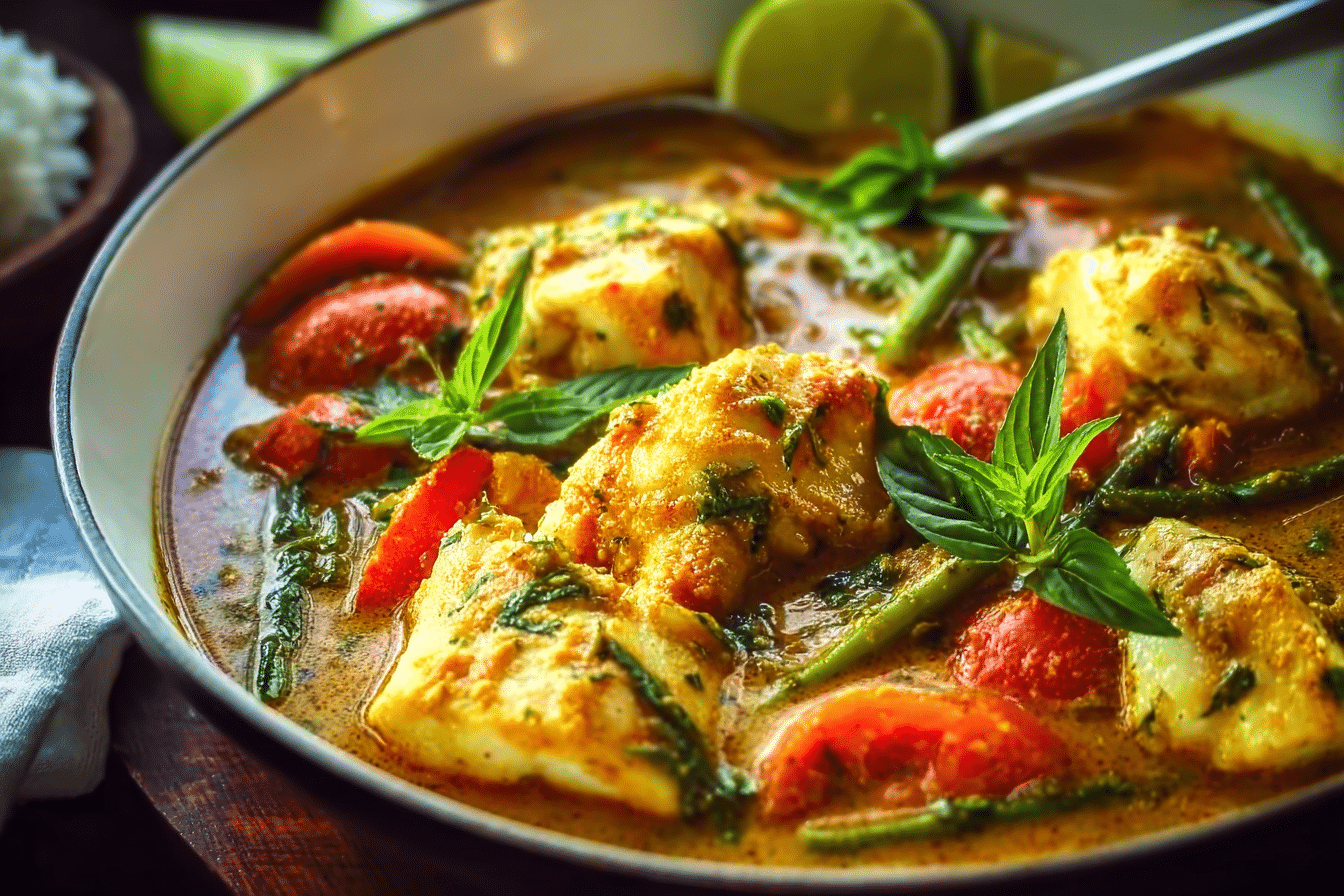
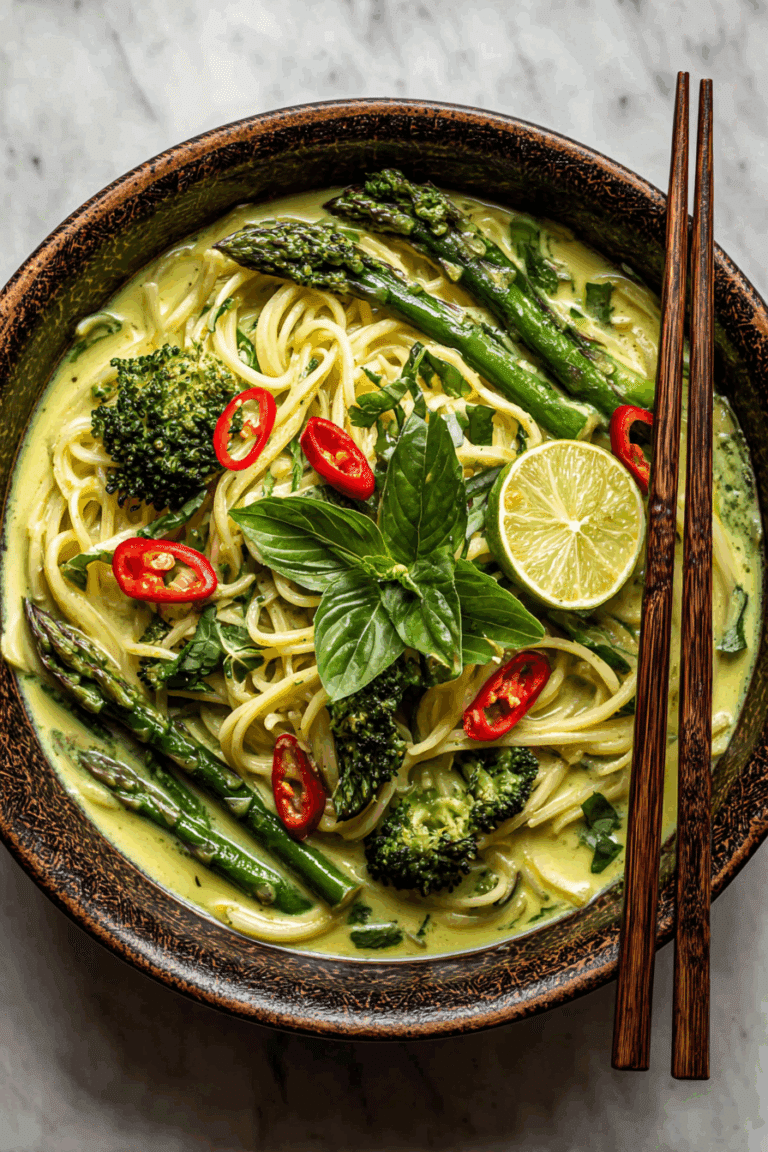
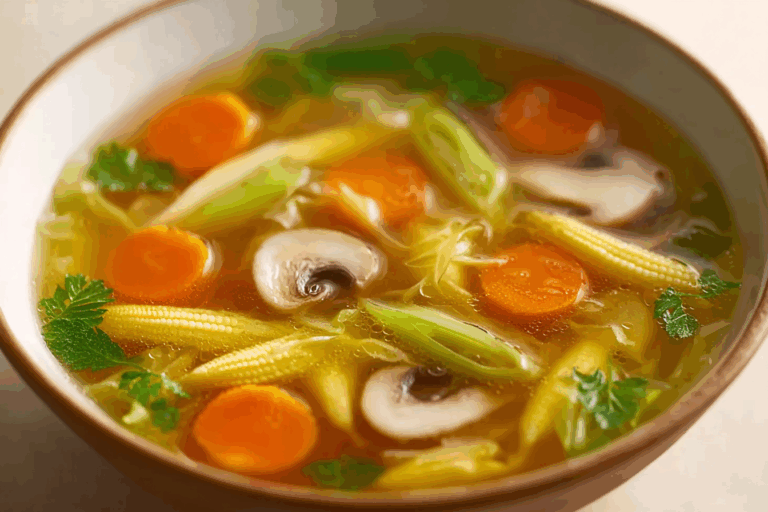



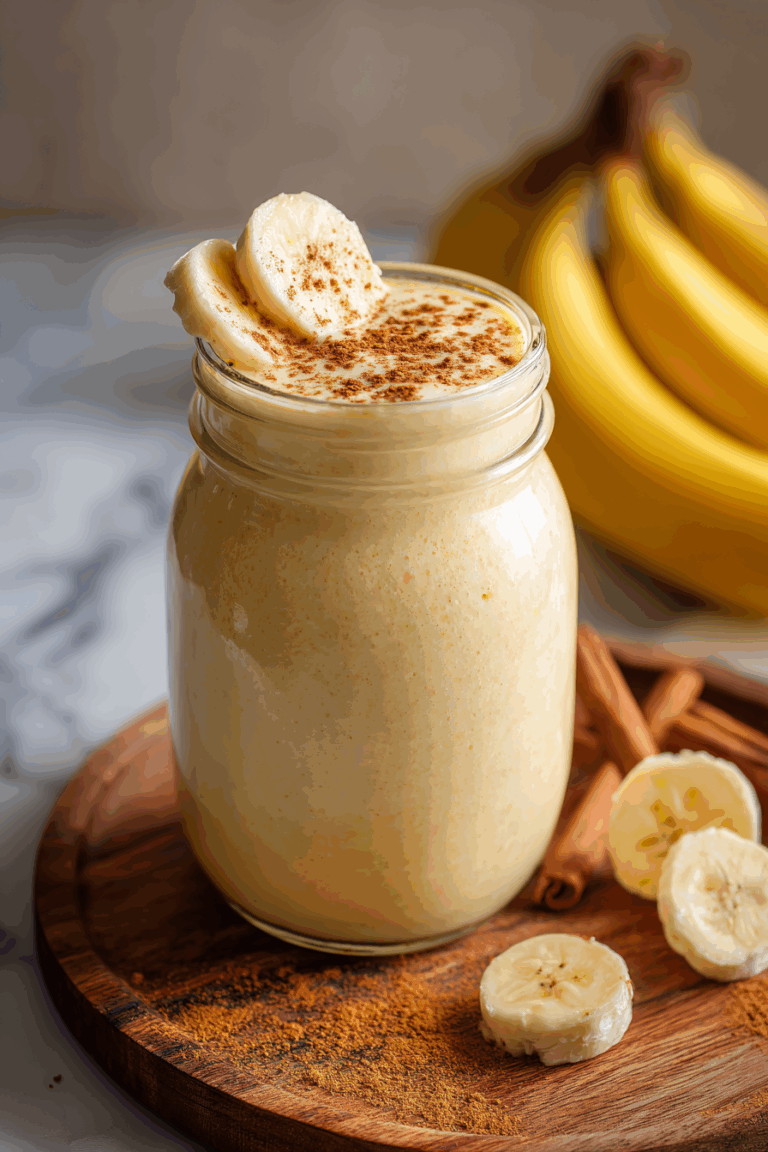
Very well written information. It will be helpful to anyone who usess it, including yours truly :). Keep up the good work – i will definitely read more posts.